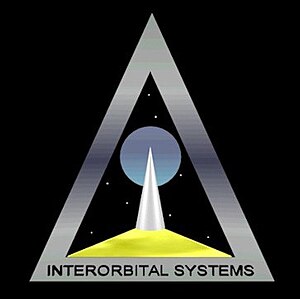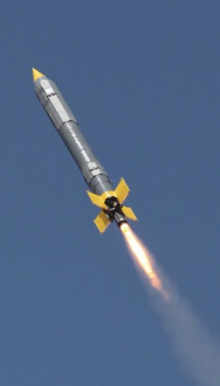 | |
| Industry | Aerospace |
|---|---|
| Founded | 1996 |
| Headquarters | Mojave, California |
| Key people | Rod Milliron and Randa Milliron (founders) |
| Products | rocket engines, rocket launch |
| Number of employees | 12 |
| Website | http://www.interorbital.com/ |
Interorbital Systems (IOS) is an American space development company based in Mojave, California. It was established in 1996 by Roderick and Randa Milliron. As of October 2023, the company is in development stage for three orbital launch vehicles: NEPTUNE, TRITON, and TRITON HEAVY.
Interorbital Systems has participated in the development of a launch vehicle for the Google Lunar X Prize Team Synergy Moon and has provided suborbital commercial launch services. For Orbital launch they have used ISRO and Jaxa. Additionally, the company participated as a competitor in the Ansari X Prize and America's Space Prize competitions.
NEPTUNE Launch Vehicle: General
The NEPTUNE rocket, a two-stage vehicle design from Interorbital Systems, would use high-performance liquid oxygen and densified propane propellants. The first stage would be equipped with four stationary throttleable ablatively cooled liquid rocket engines, each capable of generating 4,500 pounds of thrust. Throttling of these engines allows for precise control of pitch, yaw, and roll during flight.
The second stage of the NEPTUNE rocket is proposed to be powered by a single stationary ablatively cooled liquid rocket engine that generates 3,000 pounds of thrust. During the second stage engine burn and while in orbit, pitch, yaw, and roll control would be provided by cold-gas thrusters.
NEPTUNE Launch Vehicle: Pressure-fed Propulsion System
The NEPTUNE liquid rocket engines of Interorbital Systems would be fed propellants through a proprietary pressurant system. As a result, the weight of the propellant tank/pressurant system would be equivalent to a traditional propellant tank/pressurant system/pump-fed system.
By removing the propellant pump and the associated heavy electric or gas-generator pump-drive system, Interorbital Systems proposes to significantly reduce both the overall rocket development cost and the manufacturing time. This streamlined approach to the propulsion system is touted as leading to cost savings and improved efficiency in the manufacturing process.
NEPTUNE Launch Vehicle: Exclusive Ocean-based Launch
All Interorbital Systems (IOS) rockets are described as being launchable from an ocean barge equipped with motion compensation technology. Initially, IOS plans to conduct orbital flights from the Pacific Ocean southwest of Los Angeles.
In 2006, IOS held an active launch license from the Office of Commercial Space Transportation for Tachyon, a sounding rocket designed for suborbital flights reaching an apogee of 120 miles.
Preliminary design concepts
Solaris was a suborbital rocket design developed by IOS in the early 2000s. The intention behind the Solaris project was to compete for the Ansari X Prize. However, the rocket was not completed in time, and it was surpassed by Scaled Composites' SpaceShipOne, which successfully claimed the prize.
Milestones

The main engine of the Common Propulsion Module (CPM) underwent its first successful static engine firing on October 28, 2012. This composite chambered engine generated 7,500 pounds of thrust and used nitric acid and turpentine propellants.
The Common Propulsion Module Test Vehicle (CPM TV) completed its inaugural test flight on March 29, 2014, achieving a maximum altitude of 10,000 feet. The payloads on board included two CubeSats, a payload from Synergy Moon, and a music CD titled "ENCLOSURE" by John Frusciante, former guitarist of the Red Hot Chili Peppers. The CPM TV will be reused for future test flights, and all payloads were successfully recovered without damage.
Satellite kits
The CubeSat Personal Satellite Kit is available in two configurations: a standard 1 kg (2.2 lb) version and a non-standard 1.33 kg (2.93 lb) version. These kits are constructed using an aluminum frame and are designed for conducting simple experiments, as well as for receiving and transmitting radio signals. They may also be used for personal purposes.
The TubeSat Personal Satellite Kit offers an alternative to CubeSats. These kits are constructed entirely from printed circuit boards.
According to their claims, the kits will be launched into self-decaying orbits at an altitude of 310 km (192 mi), eventually burning up in the Earth's atmosphere. The company has a significant number of launches planned for both types of satellites.
Google Lunar XPrize
Interorbital Systems became a member and launch provider for Team Synergy Moon in the Google Lunar X Prize competition in June 2016. The team proposed using a modified version of the NEPTUNE rocket consisting of 36 modules to transport their lunar rover to the surface of the Moon.
See also
- Private spaceflight
- Orbital spaceflight
- Sub-orbital spaceflight
- OTRAG, which used a similar modular rocket design
- Mojave Air and Space Port
- Team Synergy Moon
- FreeFly Astronaut Project
References
- ^ "Western Pa. couple shoot to win Google Lunar XPRIZE on humble budget". 15 February 2017.
- Pittman, Carrie. "Interorbital Systems". www.cmtc.com. Retrieved 2023-10-13.
- ^ "TEAMS Google Lunar XPRIZE". Archived from the original on 2018-01-24. Retrieved 2018-01-23.
- "Launch Manifest".
- "X PRIZE Team Summary Sheet: Interorbital Systems" (PDF). X PRIZE Foundation.
- ^ Boyle, Alan (October 8, 2004). "Space racers set sights on orbital frontier: After X Prize, some rivals seek more lucrative payoff". NBC News. Archived from the original on December 3, 2015. Retrieved 2013-08-11.
- Milliron, Randa (October 2017). "Interorbital Preps for NEPTUNE Test Launch—and eleven smallsats will go along for the ride". SatMagazine. Archived from the original on 2018-01-24.
- "Neptune modular rockets for breakthrough low-cost space access". sbir.nasa.gov. Retrieved 2023-10-13.
- "Synergy Moon Presentation at 2011 GLXP Summit". YouTube. 2011-07-16. Archived from the original on 2015-12-03. Retrieved 2013-08-11.
- Milliron, Randa (2006-05-28). "Advantages of Using White Fuming Nitric Acid (WFNA) as an oXidizer in Rockets". Lunar Lander Challenged. Archived from the original on 2015-12-03. Retrieved 2013-08-11.
- ^ "CPM TV Rocket Launch 03.29.14". Archived from the original on April 7, 2014. Retrieved May 6, 2014.
- "Album Launch: John Frusciante Sends New LP Into Space on Rocket". Rolling Stone. 2014-03-31. Archived from the original on 2016-07-30. Retrieved 2016-06-27.
- "Launch Manifest". Interorbital Systems. Archived from the original on 2018-01-12.
- "Lunar Missions_1". www.interorbital.com. Archived from the original on 2016-07-06. Retrieved 2016-06-05.
- "XPRIZE Verifies Launch Agreement for Team SYNERGY MOON as Third Google Lunar XPRIZE Team Pursuing a 2017 Lunar Mission". Business Wire. 30 Aug 2016. Retrieved 4 Feb 2021.
External links
| Space tourism | |||||
|---|---|---|---|---|---|
| Organizations |  | ||||
| Vehicles |
| ||||
| Living in space | |||||
| Space competitions | |||||
| Space tourists |
| ||||
| Space tourism missions |
| ||||
| Related | |||||
| Ansari X Prize | |
|---|---|
| Competitors | |
| Winner | |
| People | |
| Media | |
| Related | |
| |